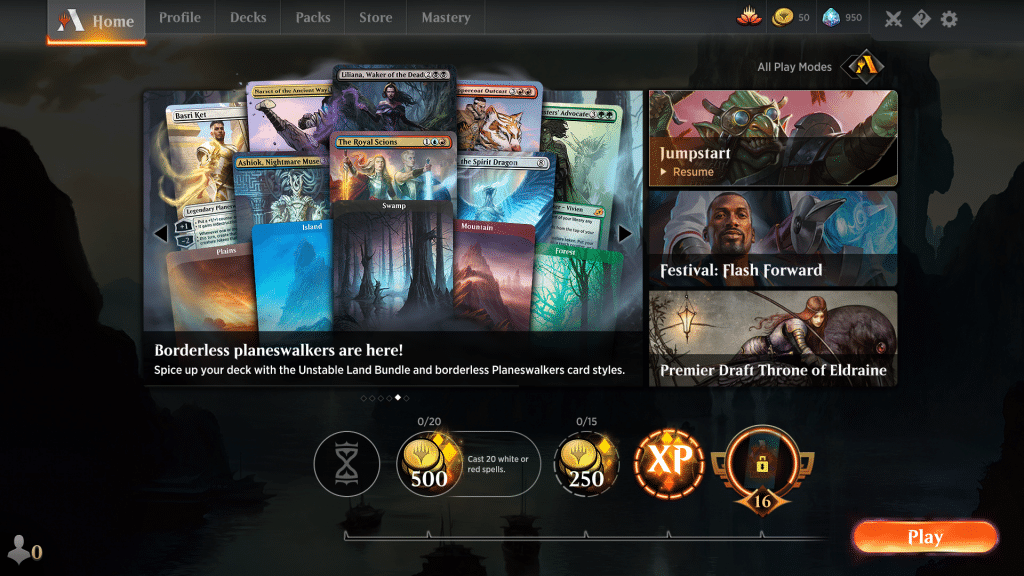I’ve been playing Magic: The Gathering on and off for many years. But I didn’t re-start until Wizards released Return to Ravnica, so I’m probably considered a late bloomer.
MTGO, the original online client to play Magic, received its fair share of attention from me. However, by the time I started, it was clear that the client was outdated and bloated. I drifted away from it, instead preferring to play games of paper Magic instead.
But all of that changed when I recently got into MTG Arena. The interface is sleek and modern, and it’s everything I want from a digital version of Magic. All that’s lacking is a complete database of every card so far.
If you’re thinking of getting started with Magic: The Gathering Arena, it’s really easy to take it for a test spin. And, it’s as free as you want it to be!
Here are my tips for starting out!
Learn the Basics of Magic: The Gathering
First thing’s first: If you don’t know how to play Magic, you’ll need to learn the basics. Luckily, MTG Arena has a fantastic tutorial that will guide you through everything that you need to know to sling spells in the five colors: White, Blue, Black, Red, and Green.
Each of the colors and decks plays a bit differently. For example, blue decks thrive on casting a lot of spells, while green decks might be about generating massive creatures. As you play, you’ll hopefully notice some synergies between the colors, and you’ll want to use these to your advantage.
- White focuses on gaining life, buffing creatures, and preventing damage
- Blue likes to cast spells, counter spells, and draw lots of cards
- Black destroys creatures, pays costs for powerful effects, and reanimates slain creatures
- Red burns foes with direct damage, aggressive creatures, and usually wants to end the game quickly
- Green generates lots of mana, summons huge creatures, and pumps their creatures with combat tricks
As you play, you’ll find yourself unlocking various currencies like coins and packs, as well as wildcards and experience points. What do they all mean? Don’t worry, they’re easily explainable.

Currencies in MTG Arena
The two main currencies in MTG Arena are the gold coins and gems. Gold coins are your reward for completing daily quests. You can have up to three daily quests active at a given time, and they’ll award either 500 or 750 gold upon completion.
Gems are considered the premium currency of the game. Typically, you’ll earn these in very small quantities. If you see something that you like in the shop, you can usually buy it with either type of currency. However, keep your eyes peeled on the Daily Deals; you’ll usually find some nice savings on a booster pack.
Currencies can also be used to play specific game modes like Booster Draft, which is one of the Limited formats. If you want to enter any tournaments, those will also have an entry fee associated with them.
Post-Tutorial Magic: The Gathering Arena
After you’re done with the tutorial, the world is your figurative burrito! Or oyster, depending on your culinary preferences.
At this point, you’ll want to make your own decks using cards in your collection. By default, you’ll only see cards that you have access to. However, as you play, you’ll unlock additional cards and open booster packs to fill out your collection.
If there are specific cards that you’re looking for, you’ll have to craft them or hope that you randomly open them in a booster pack. Crafting is a really nice feature in MTG Arena. Over time, you’ll accumulate Wildcards of specific rarities. You can cash one of these in to craft a card of the matching rarity.

Use those Rare and Mythic Rare Wildcards wisely; you are going to earn them much more slowly than the Uncommon and Common ones. Generally, those are going to be the most powerful cards, so think twice before you add one to your toolbox!
Keep in mind that the ‘Standard’ game mode rotates sets of cards out each year. On the other hand, ‘Historic’ allows you to use any cards in your library. When crafting cards to build decks you’ll want to make sure that you’re going to get a lot of mileage out of your Rare and Mythic cards if you’re using them for Standard.
Magic: The Gathering in Digital Form
This is just the first of many articles to come about MTG Arena. If you’ve only played Hearthstone in the past, Magic: The Gathering has its own benefits and shortcomings. However, why not play both?
Wizards hit it out of the park by allowing players to learn and play Magic from the comfort of their living rooms, with an excellent tutorial. It has all of the same appeal as the paper game, just with 100% less shuffling.
See you online!

